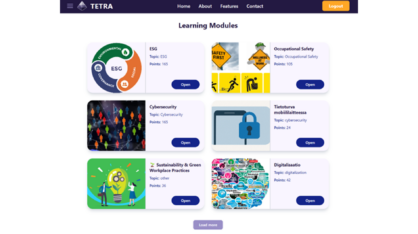Introduction
Nowadays, the use of web-based portals as a platform for providing lecture materials and other notes, instructions and tools is quite commonplace. In a typical teaching process, the educator gives lectures, presents theory, and then assigns assignments to let students put the learned theory into practice and deepen their own knowledge and skills. Based on the student solutions, the educator can evaluate how successful the teaching process has been and how students have been able to absorb the knowledge and techniques presented to them.
Assignment Review
In subjects in which assignments can be done alone without interaction with the educator, students can either do the assignments independently or get considerable help from other sources and then submit the solution via the study portal. In the next phase, the educator can review the solutions and possibly test them and give feedback. This is all possible only if the educator can successfully access the solution, download, and compile it and bypass all the possible difficulties showing up during the process. This might not always be the case if testing the student solution requires particular tools as well as configuring the tools or modifying some configurations in the solution. Experience has shown that this is not always the case and getting everything ready to test the functionality of the solution successfully could be challenging and time taking.
If the educator manages to run the student solution successfully, the solution must still be evaluated to see how well it meets its requirements. Checking the functionality of the solution and comparing it with the pre-defined requirements takes time too and can also be very inconvenient. Finding all possible shortcomings and faults in the solution is a real challenge and there is a high risk that the educator does not find all possible faults despite all efforts. On the other hand, verifying each feature requires its own effort.
Automatic Testing
Solutions can be tested automatically to verify whether they produce expected results or not. This approach can be applied to some particular types of solutions to see whether the solution produces the expected results or not. However, the problem with this approach is that it does not check the quality of the solution. For instance, in computer programming, there are lots of recommendations to be considered to make sure that code is of a proper quality. A very messy code can still produce expected results, but this does not mean that the code has been written in a sustainable, maintainable, and high-quality manner. Particularly, from an educational perspective, this approach does not provide any interaction between the student and the educator and fails to give highly needed feedback to improve the code quality and help student to gain skills and become professional in their fields.
Interaction-Based Teaching Model
There is a real need to overcome the problems with the traditional methods of education and shift to a new paradigm, with emphasis on student engagement and interactive learning experiences. The Interaction-Based Teaching Model (IBTM) is an advanced approach that emphasizes active communication and collaboration between educators and learners. The main principles of Interaction-Based Teaching are described below.
Active Participation
Encouraging students for active participation is one of the main building blocks of the interaction-based teaching model. Instead of passively receiving information, students are actively involved in discussions, problem-solving activities, and collaborative projects, leading to a deeper understanding of the subject matter.
Two-Way Communication
Two-way communication between educators and students creates an environment where questions, ideas, and feedback flow freely, breaking down traditional barriers and promoting a sense of partnership in the learning process.
Collaborative Learning
Students are encouraged to work together, share perspectives, suggest ideas, and collectively solve problems. This not only enhances understanding of the material by students but also fosters crucial teamwork and communication skills.
Application of Knowledge
The model places a strong emphasis on the practical application of knowledge instead of focusing just on theoretical concepts. Students engage in real-world scenarios, case studies, and hands-on projects, allowing them to transfer theoretical concepts into practical skills.
Paybacks of Interaction-Based Teaching
Engagement
When students actively participate in discussions and activities, they are more likely to be motivated and invested in the learning process. In this way, interaction-based teaching increases students’ interest, resulting in higher engagement levels.
Enhanced Critical Thinking
As students are prompted to analyze, evaluate, and synthesize information, they gain the courage for critical thinking. Through discussions and problem-solving activities, students develop the ability to think critically and make informed decisions.
Communication Skills
Students learn to express their thoughts clearly, listen to others, and express ideas effectively, refining skills that are crucial for success in both academic and professional contexts.
Personalized Learning
Through incorporating various interactive methods, educators can adapt their approach to respond to individual needs, promoting a more personalized and effective learning experience.
Implications for Modern Education
Adaptability to Technology
Virtual classrooms, online discussion forums, and collaborative platforms enhance the opportunities for interaction, making education more accessible and adaptable to diverse learning environments.
Preparation for the Future Workforce
The emphasis on collaboration, communication, and critical thinking in the Interaction-Based Teaching Model aligns with the skills needed in the contemporary workforce. Students are better prepared for the challenges of the professional world, where teamwork and adaptability are essential.
Promotion of Lifelong Learning
By instilling a love for active learning, the model encourages students to view education as a lifelong journey. The skills acquired through interactive learning extend beyond the classroom, promoting a mindset of continuous growth and adaptation to new information and challenges.
Conclusion
The Interaction-Based Teaching Model represents a modern and student-centric approach to education. As the educational landscape continues to evolve, the model provides a framework for creating dynamic learning environments that allow students to actively participate, collaborate, and apply knowledge. By adopting this model, educators contribute not only to the academic success of their students but also to the development of skills essential for success in the complex and interconnected world of today.




